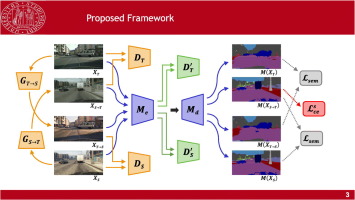Image and Vision Computing ( IF 4.2 ) Pub Date : 2020-02-01 , DOI: 10.1016/j.imavis.2020.103889 Marco Toldo , Umberto Michieli , Gianluca Agresti , Pietro Zanuttigh

|
The supervised training of deep networks for semantic segmentation requires a huge amount of labeled real world data. To solve this issue, a commonly exploited workaround is to use synthetic data for training, but deep networks show a critical performance drop when analyzing data with slightly different statistical properties with respect to the training set. In this work, we propose a novel Unsupervised Domain Adaptation (UDA) strategy to address the domain shift issue between real world and synthetic representations. An adversarial model, based on the cycle consistency framework, performs the mapping between the synthetic and real domain. The data is then fed to a MobileNet-v2 architecture that performs the semantic segmentation task. An additional couple of discriminators, working at the feature level of the MobileNet-v2, allows to better align the features of the two domain distributions and to further improve the performance. Finally, the consistency of the semantic maps is exploited. After an initial supervised training on synthetic data, the whole UDA architecture is trained end-to-end considering all its components at once. Experimental results show how the proposed strategy is able to obtain impressive performance in adapting a segmentation network trained on synthetic data to real world scenarios. The usage of the lightweight MobileNet-v2 architecture allows its deployment on devices with limited computational resources as the ones employed in autonomous vehicles.
中文翻译:

基于周期一致性和特征对齐的移动语义分段的无监督域自适应
对深度网络进行语义分割的监督训练需要大量标记的真实世界数据。为了解决此问题,通常利用的解决方法是使用合成数据进行训练,但是当分析与训练集相比统计特性稍有不同的数据时,深层网络显示出关键的性能下降。在这项工作中,我们提出了一种新颖的无监督域自适应(UDA)策略,以解决现实世界和综合表示之间的域转换问题。一个基于周期一致性框架的对抗模型执行综合域与实域之间的映射。然后将数据馈送到执行语义分段任务的MobileNet-v2体系结构。在MobileNet-v2的功能级别上,还有另外两个鉴别符,允许更好地对齐两个域分布的特征并进一步提高性能。最后,利用语义图的一致性。在对合成数据进行了初步的有监督的培训之后,整个UDA体系结构都接受了端到端培训,同时考虑了其所有组成部分。实验结果表明,提出的策略在将合成数据训练的分段网络调整到现实场景中时能够获得令人印象深刻的性能。轻巧的MobileNet-v2架构的使用允许将其部署在计算资源有限的设备上,如自动驾驶汽车所采用的设备。在对合成数据进行了初步的有监督的培训之后,整个UDA体系结构都接受了端到端培训,同时考虑了其所有组成部分。实验结果表明,提出的策略在将合成数据训练的分段网络调整到现实场景中时能够获得令人印象深刻的性能。轻巧的MobileNet-v2架构的使用允许将其部署在计算资源有限的设备上,如自动驾驶汽车所采用的设备。在对合成数据进行了初步的有监督的培训之后,整个UDA体系结构都接受了端到端培训,同时考虑了其所有组成部分。实验结果表明,提出的策略在将合成数据训练的分段网络调整到现实场景中时能够获得令人印象深刻的性能。轻巧的MobileNet-v2架构的使用允许将其部署在计算资源有限的设备上,如自动驾驶汽车所采用的设备。











































 京公网安备 11010802027423号
京公网安备 11010802027423号